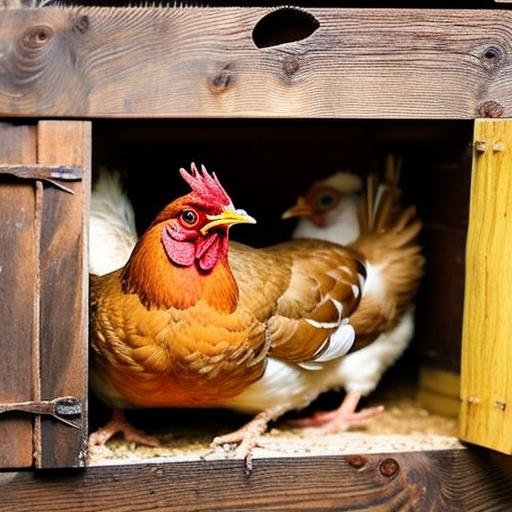Sleeping in nesting boxes for chickens is an important aspect of providing a comfortable and safe environment for your flock. Just like humans, chickens need a designated space to sleep where they can feel secure and protected. In this article, we will explore the benefits of sleeping in nesting boxes for chickens and discuss how to set up and maintain these sleeping areas.
Key Takeaways
- Sleeping in nesting boxes is important for chickens to feel safe and secure while laying eggs and sleeping.
- Choosing the right nesting boxes for your chickens involves considering the size, material, and location of the boxes.
- Setting up your chicken coop for nesting boxes requires proper placement and installation to ensure easy access and cleaning.
- Providing comfortable bedding for nesting boxes can improve egg quality and prevent health issues for your chickens.
- Keeping nesting boxes clean and hygienic is crucial for preventing the spread of disease and maintaining a healthy flock.
Why Sleeping in Nesting Boxes is Important for Chickens
Chickens need a designated space to sleep for several reasons. Firstly, sleeping in nesting boxes provides warmth and insulation. Nesting boxes are typically filled with bedding material, such as straw or wood shavings, which helps to keep the chickens warm during colder nights. Additionally, the enclosed space of a nesting box provides protection from predators. Chickens are vulnerable when they sleep, so having a secure area to rest can help keep them safe from potential threats.
Choosing the Right Nesting Boxes for Your Chickens
When selecting nesting boxes for your chickens, it is important to consider the size and material of the boxes. The size of the nesting boxes should be appropriate for the size of your flock. A general rule of thumb is to have one nesting box for every four to five hens. This ensures that each chicken has enough space to comfortably sleep and lay eggs.
The material of the nesting boxes is also important. Wood is a popular choice as it provides insulation and is durable. However, plastic or metal nesting boxes can also be used as long as they are properly insulated and provide enough space for the chickens.
Setting Up Your Chicken Coop for Nesting Boxes
Properly positioning and installing nesting boxes in your chicken coop is crucial for creating a comfortable sleeping environment for your chickens. The nesting boxes should be placed in a quiet and secluded area of the coop, away from high traffic areas and noise. This will provide your chickens with privacy and reduce stress levels.
The nesting boxes should also be installed at a height that is easily accessible for the chickens. Placing them too high or too low can make it difficult for the chickens to enter and exit the boxes. Additionally, make sure to secure the nesting boxes to prevent them from moving or falling over.
Providing Comfortable Bedding for Nesting Boxes
Bedding material is an important aspect of creating a comfortable sleeping environment for your chickens. There are several options available, including straw, wood shavings, and shredded paper. Each material has its pros and cons.
Straw is a popular choice as it provides good insulation and is readily available. However, it can become moldy if it gets wet and needs to be replaced regularly. Wood shavings are another common option as they are absorbent and provide good insulation. However, they can be dusty and may need to be replaced more frequently.
Keeping Nesting Boxes Clean and Hygienic

Keeping nesting boxes clean is essential for maintaining a healthy environment for your chickens. Dirty nesting boxes can attract pests and lead to the spread of diseases. Regularly cleaning out the bedding material and replacing it with fresh material is important.
Additionally, inspect the nesting boxes regularly for any signs of damage or wear. Repair or replace any damaged nesting boxes to ensure that they remain secure and comfortable for your chickens.
Encouraging Chickens to Sleep in Nesting Boxes
Some chickens may need a little encouragement to start using the nesting boxes for sleeping. One way to encourage them is by placing treats inside the nesting boxes. This will entice the chickens to explore the boxes and associate them with positive experiences.
Another method is to train the chickens to sleep in the nesting boxes by gently placing them inside at night. Repeat this process for several nights until they become accustomed to sleeping in the boxes.
Dealing with Chickens Who Refuse to Sleep in Nesting Boxes
While most chickens will eventually adapt to sleeping in nesting boxes, some may refuse to use them. In this case, it is important to provide alternative sleeping options. This can include roosting bars or platforms where the chickens can sleep comfortably.
It is also important to observe the behavior of the chickens and try to identify any underlying issues that may be causing them to avoid the nesting boxes. This can include overcrowding, bullying, or discomfort in the nesting boxes. Addressing these issues can help encourage the chickens to start using the nesting boxes for sleeping.
Common Mistakes to Avoid When Keeping Chickens in Nesting Boxes
There are several common mistakes that chicken owners make when setting up and maintaining nesting boxes. One common mistake is not providing enough nesting boxes for the flock. This can lead to overcrowding and competition for sleeping space.
Another mistake is not keeping the nesting boxes clean and hygienic. Dirty nesting boxes can attract pests and lead to the spread of diseases among your flock. Regularly cleaning out the bedding material and inspecting the boxes for any signs of damage or wear is important.
The Benefits of a Good Night’s Sleep for Your Chickens
Providing a comfortable and safe sleeping environment for your chickens is crucial for their health and well-being. Sleeping in nesting boxes offers several benefits, including warmth, protection from predators, and a sense of security. By choosing the right nesting boxes, setting up your chicken coop properly, providing comfortable bedding, and maintaining cleanliness, you can ensure that your chickens get a good night’s sleep. This will contribute to their overall health and productivity.
If you’re looking for the best way to keep chickens comfortable and well-rested, you’ll want to check out this informative article on Poultry Wizard. They provide valuable insights on how to ensure your chickens sleep soundly in their nesting boxes. From choosing the right bedding material to creating a cozy environment, this article covers all the essential tips and tricks. For more helpful resources on poultry care, be sure to explore Poultry Wizard’s website, including their article on the Snaplock Chicken Coop (https://poultrywizard.com/keeping-chickens/snaplock-chicken-coop/) and their guide on whether quails sit on their eggs (https://poultrywizard.com/breeding-quail/do-quails-sit-on-their-eggs/). Happy chicken keeping!
FAQs
What are nesting boxes?
Nesting boxes are small, enclosed spaces where chickens can lay their eggs and sleep comfortably.
Why is it important for chickens to sleep in nesting boxes?
Sleeping in nesting boxes helps chickens feel safe and secure, which can reduce stress and improve egg production.
What is the best way to set up nesting boxes?
Nesting boxes should be placed in a quiet, dark area of the coop and lined with soft bedding material such as straw or wood shavings. The boxes should be large enough for the chickens to comfortably stand up and turn around in.
How many nesting boxes do I need?
A good rule of thumb is to have one nesting box for every four to five chickens. However, some chickens may prefer to share a box, so it’s important to observe their behavior and adjust accordingly.
How often should I clean the nesting boxes?
Nesting boxes should be cleaned regularly to prevent the buildup of bacteria and parasites. Depending on the number of chickens and the size of the boxes, cleaning may need to be done daily or weekly.
What are some common mistakes to avoid when setting up nesting boxes?
Common mistakes include placing the boxes in a high-traffic area, using hard or uncomfortable bedding material, and not providing enough space for the chickens to move around. It’s also important to make sure the boxes are secure and free from drafts.
Meet Walter, the feathered-friend fanatic of Florida! Nestled in the sunshine state, Walter struts through life with his feathered companions, clucking his way to happiness. With a coop that’s fancier than a five-star hotel, he’s the Don Juan of the chicken world. When he’s not teaching his hens to do the cha-cha, you’ll find him in a heated debate with his prized rooster, Sir Clucks-a-Lot. Walter’s poultry passion is no yolk; he’s the sunny-side-up guy you never knew you needed in your flock of friends!







